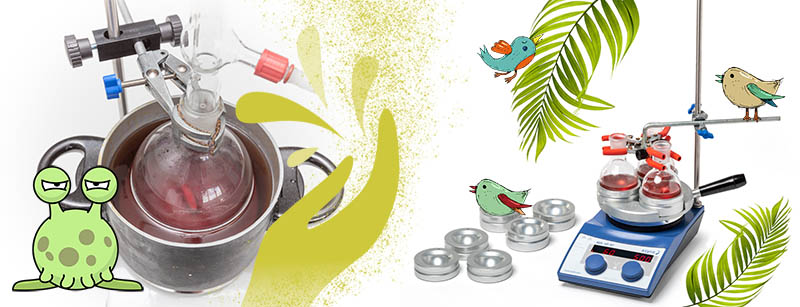Oil, water, and sand baths are often used in laboratories to supply a steady heat source for the thermodynamic control of reaction mixtures. In an oil bath, a thermometer is used to monitor the temperature of the oil, which, in turn, heats a liquid in a flask. A hot plate or hot plate stirrer heats the oil to about 230oC. An oil bath may also be used in conjunction with a water-cooled condenser 1.
Despite enabling the controlled heating of reaction mixtures, oil baths pose significant fire and injury risks to laboratory staff. In this article, we will discuss the dangers of using these baths and present some alternatives.
What Are Oil Baths?
Much like water baths, oil baths are containers of oil heated by a hot plate or coiled wire. Silicone oil is most commonly used although mineral oil, cottonseed oil, and others are also used. A mineral oil bath may be heated up to 300oC, while a silicone oil bath may be heated to about 250oC 1, 2. Mineral oil, however, is combustible and should not come into direct contact with open flames.
These oils are heated inside a Pyrex® glass container or porcelain dish sitting on a hot plate or hot plate stirrer. Alternatively, a coiled wire — connected to a Variac — may be immersed in the oil 2. The Variac is itself connected to a power outlet and enables the controlled delivery of a voltage to the wire.
Because the entire exterior of a container is heated, an oil bath provides even heating of reaction mixtures.
Commonly used silicone oil has a good reaction range between 25°C and 230°C, with a flash point between 150°C and 350°C 3. However, it is slippery and tends to degrade over time. It will also spatter whenever water is introduced unintentionally.
Hazards of Using Oil Baths
Despite enabling controlled heating of reaction mixtures, oil baths are messy to use: the glassware may become dirty, the oil may become sludgy, and the baths may break and cause spillage. More importantly, oil baths pose a fire risk, especially if heated beyond flash points 3,4.
The hazards of using oil baths include:
- Fires caused by overheating
- Obnoxious smells
- Serious splattering due to accidental mixing of oil with water or solvents
- Skin burns caused by spilt or splashed oil
- Flasks becoming dangerously slippery
- Oil spills on floors causing slips
Alternatives to Oil Baths
Asynt supplies the DrySyn range of laboratory heating blocks as an ideal alternative to oil baths. A recent study demonstrated that, when used in conjunction with a CondenSyn glass condenser, a DrySyn heating block provides significant cost savings when compared with using oil baths 1. Furthermore, in the absence of oil baths, the use of fume cupboard space is cut by two-thirds, further reducing HVAC running costs.
DrySyn heating blocks provide for safe, clean synthesis during single or multiple reactions while also meeting environmental sustainability standards. Flat bases with removable and re-positionable feet ensure compatibility with any magnetic hot plate stirrer. Suitable for use with a wide range of round-bottomed flasks, tubes, and vials up to 500 mL, DrySyn heating blocks enable:
- Safe ramping of temperatures to 300oC
- Safe and easy lifting due to heat-resistant handles
- The elimination of hazards and clean-up costs associated with oil spillages
- The elimination of fire risks associated with mixing water or solvents with oil
- Excellent reaction visibility due to low well design (which also prevents the cracking of glassware)
DrySyn heating blocks are supplied in a clear, anodized finish which, while chemically and solvent resistant, are fully recyclable.
Contact form
References
- Asynt.com. Triple Reaction Drysyn Vs.Oil Bath. [online] Available at: https://www.asynt.com/wp-content/uploads/2007/02/Green-Light-Laboratories-DrySyn-MULTI-vs-Oil-Bath-Report.pdf
- Nichols, L. (2017) Water, sand, and oil baths. Chemistry LibreTexts. [online]. Available at: https://chem.libretexts.org/Bookshelves/Organic_Chemistry/Organic_Chemistry_Lab_Techniques_(Nichols)/01%3A_General_Techniques/1.04%3A_Heating_and_Cooling_Methods/1.4H%3A_Water_Sand_and_Oil_Baths
- University of Iowa. Oil baths in laboratories. Environmental Health and Safety [online] Available at: https://ehs.research.uiowa.edu/oil-baths-laboratories
- Addinol (2020) Flash point of oil – Definition and facts to know. [online] Available at: https://addinol.de/en/service-en/expert-tip/flash-point/





